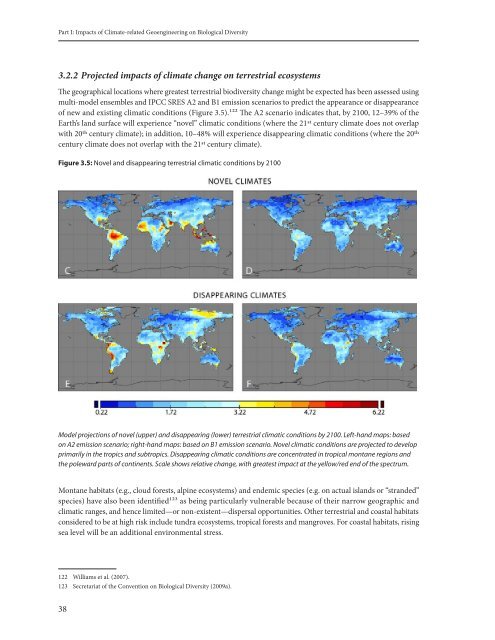cbd-ts-66-en
cbd-ts-66-en
cbd-ts-66-en
Create successful ePaper yourself
Turn your PDF publications into a flip-book with our unique Google optimized e-Paper software.
Part I: Impac<strong>ts</strong> of Climate-related Geo<strong>en</strong>gineering on Biological Diversity<br />
3.2.2 Projected impac<strong>ts</strong> of climate change on terrestrial ecosystems<br />
The geographical locations where greatest terrestrial biodiversity change might be expected has be<strong>en</strong> assessed using<br />
multi-model <strong>en</strong>sembles and IPCC SRES A2 and B1 emission sc<strong>en</strong>arios to predict the appearance or disappearance<br />
of new and existing climatic conditions (Figure 3.5).122 The A2 sc<strong>en</strong>ario indicates that, by 2100, 12–39% of the<br />
Earth’s land surface will experi<strong>en</strong>ce “novel” climatic conditions (where the 21st c<strong>en</strong>tury climate does not overlap<br />
with 20th c<strong>en</strong>tury climate); in addition, 10–48% will experi<strong>en</strong>ce disappearing climatic conditions (where the 20th<br />
c<strong>en</strong>tury climate does not overlap with the 21st c<strong>en</strong>tury climate).<br />
Figure 3.5: Novel and disappearing terrestrial climatic conditions by 2100<br />
Model projections of novel (upper) and disappearing (lower) terrestrial climatic conditions by 2100. Left-hand maps: based<br />
on A2 emission sc<strong>en</strong>ario; right-hand maps: based on B1 emission sc<strong>en</strong>ario. Novel climatic conditions are projected to develop<br />
primarily in the tropics and subtropics. Disappearing climatic conditions are conc<strong>en</strong>trated in tropical montane regions and<br />
the poleward par<strong>ts</strong> of contin<strong>en</strong><strong>ts</strong>. Scale shows relative change, with greatest impact at the yellow/red <strong>en</strong>d of the spectrum.<br />
Montane habita<strong>ts</strong> (e.g., cloud fores<strong>ts</strong>, alpine ecosystems) and <strong>en</strong>demic species (e.g. on actual islands or “stranded”<br />
species) have also be<strong>en</strong> id<strong>en</strong>tified123 as being particularly vulnerable because of their narrow geographic and<br />
climatic ranges, and h<strong>en</strong>ce limited—or non-exist<strong>en</strong>t—dispersal opportunities. Other terrestrial and coastal habita<strong>ts</strong><br />
considered to be at high risk include tundra ecosystems, tropical fores<strong>ts</strong> and mangroves. For coastal habita<strong>ts</strong>, rising<br />
sea level will be an additional <strong>en</strong>vironm<strong>en</strong>tal stress.<br />
122 Williams et al. (2007).<br />
123 Secretariat of the Conv<strong>en</strong>tion on Biological Diversity (2009a).<br />
38


